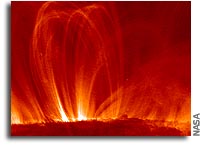Joint USAF/NOAA Report of Solar and Geophysical Activity 16 Feb 2003

SDF Number 047 Issued at 2200Z on 16 Feb 2003
IA. Analysis of Solar Active Regions and Activity from 15/2100Z
to 16/2100Z: Solar activity was at low levels. The largest event
was a C1.1 flare on the west limb at 16/0325 UTC. The most likely
source of this flare was Region 276 (S14, L=160) as determined by
NOAA/SXI imagery. Region 288 (N11E59) has rotated further onto the
visible disk revealing a DSO spot group with a beta magnetic
configuration. The plage of Region 288 exhibited nearly constant
surging. Region 282 (N11E82) produced plage fluctuations and has
shown some decrease in area coverage.
IB. Solar Activity Forecast: Solar activity is expected to be very
low to low. Region 282 and 288 have the potential for C-class
flares.
IIA. Geophysical Activity Summary 15/2100Z to 16/2100Z:
The geomagnetic field was at quiet to active levels. Coronal hole
effects continue with solar wind gradually increasing to near 650
km/s and Bz continuing to be, on average, slightly southward. Major
storming conditions were observed at higher latitudes.
IIB. Geophysical Activity Forecast: The geomagnetic field is
expected to be at quiet to active levels. Peak activity is expected
on day two of the period.
III. Event Probabilities 17 Feb-19 Feb
- Class M 05/05/05
- Class X 01/01/01
- Proton 01/01/01
- PCAF green
IV. Penticton 10.7 cm Flux
- Observed 16 Feb 119
- Predicted 17 Feb-19 Feb 115/115/115
- 90 Day Mean 16 Feb 147
V. Geomagnetic A Indices
- Observed Afr/Ap 15 Feb 014/018
- Estimated Afr/Ap 16 Feb 013/014
- Predicted Afr/Ap 17 Feb-19 Feb 015/020-018/030-015/020
VI. Geomagnetic Activity Probabilities 17 Feb-19 Feb
A. Middle Latitudes
- Active 40/45/40
- Minor storm 20/25/20
- Major-severe storm 05/10/05
B. High Latitudes
- Active 40/40/40
- Minor storm 30/35/30
- Major-severe storm 15/20/15








